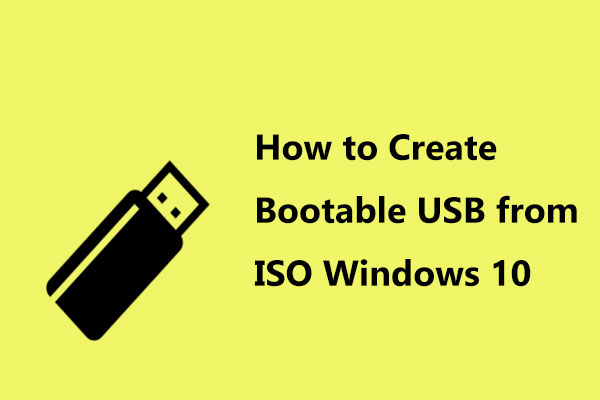
:max_bytes(150000):strip_icc()/002_how-to-burn-an-iso-file-to-a-usb-drive-2619270-5c6372fb46e0fb00017c26f2.jpg)
- #HOW TO CREATE A BOOTABLE ISO WINDOWS 10 FROM FILES INSTALL#
- #HOW TO CREATE A BOOTABLE ISO WINDOWS 10 FROM FILES PORTABLE#
- #HOW TO CREATE A BOOTABLE ISO WINDOWS 10 FROM FILES PRO#
- #HOW TO CREATE A BOOTABLE ISO WINDOWS 10 FROM FILES WINDOWS 7#
- #HOW TO CREATE A BOOTABLE ISO WINDOWS 10 FROM FILES DOWNLOAD#
#HOW TO CREATE A BOOTABLE ISO WINDOWS 10 FROM FILES WINDOWS 7#
If you are Windows 11, Windows 10 Home, Windows 8/8.1 Home/ Pro/Education, or Windows 7 user, you can’t enjoy Windows To Go function. ▪ This operation will erase all data on the destination USB drive, thus you should back up the necessary data on it in advance.

▪ The capacity of the target USB drive should not be less than 32GB. Click Yes or No to make this computer boot from the new created Windows 10 USB drive. Choose whether to use BitLocker in the USB drive. Click “ Add search location” to search for the Windows 10 installation ISO file and choose the mounted ISO file.
#HOW TO CREATE A BOOTABLE ISO WINDOWS 10 FROM FILES INSTALL#
In the Create a Windows To Go workspace window, choose the certified USB drive onto which you want to install Windows 10 and click “ Next”. Click Windows button and go to Control Panel > Windows To Go. Mount the ISO file and connect a certified USB drive to your Windows 10 computer. If you are running Windows 10 Enterprise/Education/Pro edition, you can use Windows built-in function, Windows To Go to create a Windows 10 bootable USB drive.
#HOW TO CREATE A BOOTABLE ISO WINDOWS 10 FROM FILES PORTABLE#
✔ Make Windows 10 bootable USB drive from ISO for portable Windows environment Note: You should replace N and G with the right drive letters for the USB drive and Windows 10 ISO image receptively. Then, run those commands and wait for the process to complete. Note: g is the drive letter of your mount drive as it appears in File Explorer. go to the boot folder of the Windows 10 ISO files by running the commands listed below: ▪ assign letter=m (m is the drive letter that you want to assign to the USB drive) ▪ format fs=ntfs quick (if you plan to create UEFI bootable USB of Windows 10, replace “format fs=ntfs quick” with “format fs=fat32 quick” to the USB into FAT32 file system) ▪ select disk n (n is the disk number of the USB drive) Press Windows + R, input cmd, and press Enter. Prepare an empty USB whose capacity should not be smaller than 4GB (for Windows 10 32bit) or 8GB (for 64GB). If you intend to install Windows 10 on SSD or HDD from USB drive, you can make a bootable USB drive from ISO via Diskpart utility. ✔ Create bootable Windows USB from ISO for installing Windows PS.: It is supposed that you have downloaded Windows 10 ISO file from Microsoft and mounted the ISO file. You can choose a proper way to make a bootable USB drive of Windows 10 from ISO based on your specific demand: How to: create Windows 10 bootable USB from ISO for two purposes ▪ Get a portable Windows 10 environment: It’s available to create a Windows 10 To Go disk with a USB drive from ISO, and then you can use the familiar Windows 10 environment even when you are in different places. ▪ Make Windows 10 clean installation: You can create a bootable USB of Windows 10 via Diskpart and then boot from it to install Windows 10. Generally, there are two reasons for you to make bootable Windows 10 USB from ISO file. This will ensure your USB thumb drive is working properly which may be preventing a successful completion.Why create Windows 10 bootable USB from ISO? Expand "Show advanced format options" under Format options in Rufus and check the option to "Check device for bad blocks".
#HOW TO CREATE A BOOTABLE ISO WINDOWS 10 FROM FILES PRO#
Pro Tip: If you are having issues creating your bootable USB thumb drive. The process may take several minutes depending on the speed of your USB thumb drive. Click OK on the confirmation screen to begin creating your bootable USB drive. The Format Options can usually be left as is, hit Start when you are ready. Once selected, just hit Open.įor image option, partition scheme and target system, I suggest using the defaults which are "Standard Windows Installation", GPT Partition Scheme and UEFI target system.
#HOW TO CREATE A BOOTABLE ISO WINDOWS 10 FROM FILES DOWNLOAD#
If you need to download a Windows 10 ISO file, check out this article. Next, click Select and navigate to your ISO file you want to use. To be safe, I typically use a 16GB thumb drive by Transcend.īy default, Rufus will only display removable USB drives but make sure the correct device is selected under Drive Properties. Make sure that your USB thumb drive is larger than the ISO file downloaded. Once installed, plug in your USB thumb drive and then start up Rufus. Alternatively you can download directly from the Github repository here. To get started, head over to and download Rufus 3.12 or later. This is very helpful when performing a clean install of the Windows 10 20H2 October update ISO. But recently I switched to using a new tool called Rufus that is both reliable at successfully creating bootable media and automating many steps to quickly get the job done so you can perform a clean install. I've written about a few methods over the years to create a bootable USB flash drive from a Windows 10 ISO file.


 0 kommentar(er)
0 kommentar(er)
